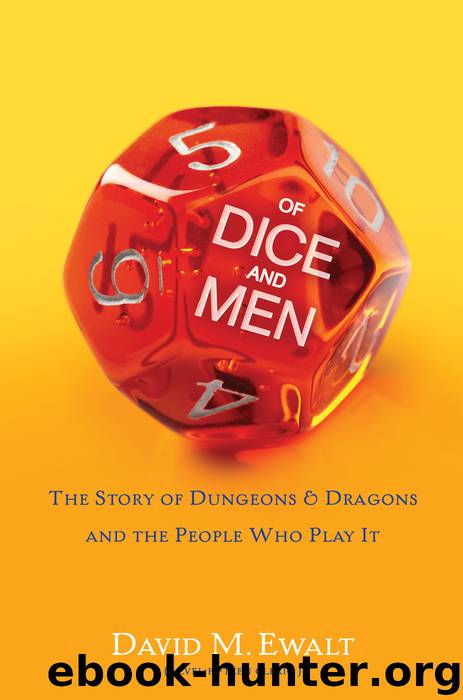Of Dice and Men by David M. Ewalt

Author:David M. Ewalt
Language: eng
Format: epub
Publisher: Scribner
* * *
By the summer of 1978, TSR had eighteen full-time employees, several dozen successful products, and at least a hundred thousand devoted fans of its games around the world. A survey published in the June issue of the Judges Guild Journal indicated that the average role-playing game fan was a twenty-one-year-old male9 college student, with all the free time for games and disposable income that demographic implies.
Finally, just in time for Gen Con XI in August, TSR delivered a new edition of Dungeons & Dragons. While the Monster Manual may have been the first book to bear the AD&D moniker, it collected only descriptions of creatures and didn’t actually contain much in the way of new and revised rules; in contrast, the Advanced Dungeons & Dragons Players Handbook offered 128 pages of detailed instructions. Gygax hadn’t just revised D&D—he’d rewritten and expanded it into a whole new game.
Sure, the core was familiar. AD&D preserved all the good stuff from the original D&D rules and supplements: characters had the same ability categories (strength, intelligence, wisdom, constitution, dexterity, and charisma) and were still sorted into a few basic professions. But while the original Men & Magic booklet spent less than a thousand words describing the game’s main classes (fighting man, magic-user, and cleric), the Players Handbook dedicated more than fifteen thousand words to five core classes (cleric, fighter, magic-user, thief, and monk) and five subclasses (druid, paladin, ranger, illusionist, and assassin). Each was fleshed out and detailed: Clerics, for instance, were now required to maintain a relationship with a specific deity, carrying its holy symbol, showing devotion through daily prayers, and behaving in a manner pleasing to that god. Failure to comply could result in the revocation of magical ability, since a cleric’s powers were bestowed in return for “diligent prayers and deeds.”
The Players Handbook focused heavily on character creation, offering lots of rich detail and opportunities for personalization. In addition to the ten core classes, players chose between seven playable “races”—dwarf, elf, gnome, halfling, human, half-elf, and half-orc. They picked one of nine “alignments” (chaotic evil, chaotic good, chaotic neutral, lawful evil, lawful good, lawful neutral, neutral evil, neutral good, and true neutral) that provided a loose description of their character’s moral code.10 They determined what languages the character could speak (from a pool including Lizardman, Hobgoblin, Kobold, and Orcish) and what equipment they carried; the handbook describes a monetary system (1,000 copper pieces = 100 silver pieces = 10 electrum pieces = 5 gold pieces = 1 platinum piece) and provides long lists of gear to make each hero unique (low, soft boots cost 8 silver pieces, and a ten-foot pole costs 3 coppers).
For all its detail, the Players Handbook doesn’t spend much time actually describing how the game is played; the book only covers what a player needs to know to get started, like how to move and fight. Gygax hid much of the game’s inner workings behind a curtain, promising those rules in the upcoming Dungeon Masters Guide.
Download
This site does not store any files on its server. We only index and link to content provided by other sites. Please contact the content providers to delete copyright contents if any and email us, we'll remove relevant links or contents immediately.
| Battletech | Call of Cthulhu |
| Dungeons & Dragons | GURPS |
| Other Role-Playing Games | Pathfinder |
| Savage Worlds | Shadowrun |
| Strategy | Trading Card Games |
| Traveller | Warhammer |
| World of Darkness |
Arthas: Rise of the Lich King by Christie Golden(1766)
World of Warcraft Chronicle Volume 3 by Blizzard Entertainment(1380)
Pillars of Eternity Guidebook by Obsidian Entertainment(1279)
1628927445Game by Unknown(1258)
The Ultimate Player's Guide to Minecraft by Stephen O'Brien(1187)
Dark Elf 02 - Exile by R. A. Salvatore(1175)
Drizzt - 01 - Homeland by R.A. Salvatore(1155)
Salvatore 1 - The Crystal Shard by Salvatore R. A(1145)
Road Games by Road Games(1136)
Starcraft by Blizzard Entertainment(1108)
Gaslands by Mike Hutchinson(1095)
Playing by the Rules(1086)
The Host by The Host(1069)
The Halfling's Gem by Salvatore R. A(1041)
The Cthulhu Wars by Kenneth Hite(1019)
Dark Elf Trilogy 01 - Homeland by R.A. Salvatore(1016)
Slaves to Darkness 03 (The Heart of Chaos) by Warhammer(951)
Binging with Babish by Andrew Rea(915)
The Book of Fantasy by Unknown(905)
